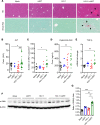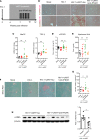Type I interferons and TGF-β cooperate to induce liver fibrosis during HIV-1 infection under antiretroviral therapy
- PMID: 35639478
- PMCID: PMC9310524
- DOI: 10.1172/jci.insight.152738
Type I interferons and TGF-β cooperate to induce liver fibrosis during HIV-1 infection under antiretroviral therapy
Abstract
Liver diseases have become a major comorbidity health concern for people living with HIV-1 (PLWH) treated with combination antiretroviral therapy (cART). To investigate if HIV-1 infection and cART interact to lead to liver diseases, humanized mice reconstituted with progenitor cells from human fetal livers were infected with HIV-1 and treated with cART. We report here that chronic HIV-1 infection with cART induced hepatitis and liver fibrosis in humanized mice, associated with accumulation of M2-like macrophages (M2LMs), elevated TGF-β, and IFN signaling in the liver. Interestingly, IFN-I and TGF-β cooperatively activated human hepatic stellate cells (HepSCs) in vitro. Mechanistically, IFN-I enhanced TGF-β-induced SMAD2/3 activation in HepSCs. Finally, blockade of IFN-I signaling reversed HIV/cART-induced liver diseases in humanized mice. Consistent with the findings in humanized mice with HIV-1 and cART, we detected elevated markers of liver injury, M2LMs, and of IFN signaling in blood specimens from PLWH compared with those of healthy individuals. These findings identify the IFN-I/M2LM/HepSC axis in HIV/cART-induced liver diseases and suggest that inhibiting IFN-I signaling or M2LM may provide a novel therapeutic strategy for treating HIV/cART-associated liver diseases in PLWH treated with antiretroviral therapy.
Keywords: AIDS/HIV; Fibrosis; Inflammation; Macrophages; Mouse models.
Conflict of interest statement
Figures







Similar articles
-
Pathogenic Role of Type I Interferons in HIV-Induced Immune Impairments in Humanized Mice.Curr HIV/AIDS Rep. 2019 Jun;16(3):224-229. doi: 10.1007/s11904-019-00444-7. Curr HIV/AIDS Rep. 2019. PMID: 31055732 Free PMC article. Review.
-
Blocking type I interferon signaling enhances T cell recovery and reduces HIV-1 reservoirs.J Clin Invest. 2017 Jan 3;127(1):269-279. doi: 10.1172/JCI90745. Epub 2016 Dec 12. J Clin Invest. 2017. PMID: 27941247 Free PMC article.
-
cART Restores Transient Responsiveness to IFN Type 1 in HIV-Infected Humanized Mice.J Virol. 2022 Nov 9;96(21):e0082722. doi: 10.1128/jvi.00827-22. Epub 2022 Oct 17. J Virol. 2022. PMID: 36250708 Free PMC article.
-
Specific Activation In Vivo of HIV-1 by a Bromodomain Inhibitor from Monocytic Cells in Humanized Mice under Antiretroviral Therapy.J Virol. 2019 May 29;93(12):e00233-19. doi: 10.1128/JVI.00233-19. Print 2019 Jun 15. J Virol. 2019. PMID: 30971469 Free PMC article.
-
The HIV Reservoir in Monocytes and Macrophages.Front Immunol. 2019 Jun 26;10:1435. doi: 10.3389/fimmu.2019.01435. eCollection 2019. Front Immunol. 2019. PMID: 31297114 Free PMC article. Review.
Cited by
-
Evaluation of the interaction between tumor growth factor-β and interferon type I pathways in patients with COVID-19: focusing on ages 1 to 90 years.BMC Infect Dis. 2023 Apr 18;23(1):248. doi: 10.1186/s12879-023-08225-9. BMC Infect Dis. 2023. PMID: 37072722 Free PMC article.
-
Type I IFN in Glomerular Disease: Scarring beyond the STING.Int J Mol Sci. 2024 Feb 21;25(5):2497. doi: 10.3390/ijms25052497. Int J Mol Sci. 2024. PMID: 38473743 Free PMC article. Review.
-
TGF-β signaling in health, disease, and therapeutics.Signal Transduct Target Ther. 2024 Mar 22;9(1):61. doi: 10.1038/s41392-024-01764-w. Signal Transduct Target Ther. 2024. PMID: 38514615 Free PMC article. Review.
-
CD24-Fc resolves inflammation and enhances anti-HIV CD8 T cells with polyfunctionality during HIV-1 infection under cART.PLoS Pathog. 2025 Aug 8;21(8):e1012826. doi: 10.1371/journal.ppat.1012826. eCollection 2025 Aug. PLoS Pathog. 2025. PMID: 40779581 Free PMC article.
-
Persistent hepatitis B virus and HIV coinfections in dually humanized mice engrafted with human liver and immune system.J Med Virol. 2023 Jul;95(7):e28930. doi: 10.1002/jmv.28930. J Med Virol. 2023. PMID: 37403703 Free PMC article.
References
Publication types
MeSH terms
Substances
Grants and funding
LinkOut - more resources
Full Text Sources
Medical

